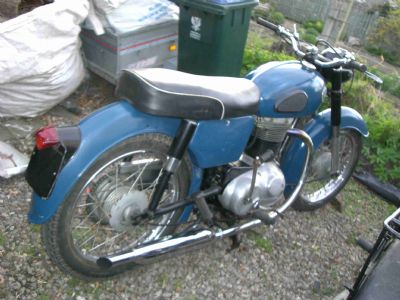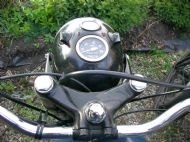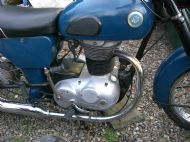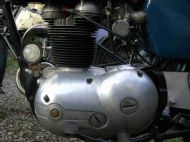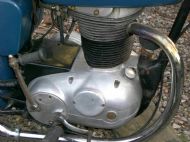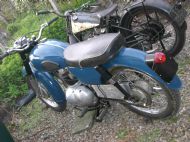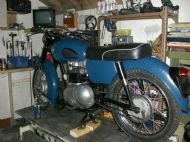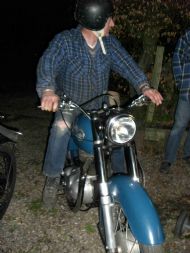 On Any Monday | sitemap | log in On Any Monday | sitemap | log in
|
 |
||
| This is a free Spanglefish 1 website. | ||
1961 AJS Model 8Owned by Frank from Dundee.
Not even modern in it's day but a decent old bike The AJS lightweight model 8 is a 350 cc single cylinder motorcycle made from approximately 1960 to 1962. It was an attempt to update the model 16 that was a highly successful motorcycle with a re-design for the engine and a styling makeover. The terms “re-design” and “styling makeover” are used in their widest possible application. Hideously heavy for a lightweight, it bears more than a passing resemblance to it's heavyweight predecessor, particularly in the top end of the engine and side panels. Clearly the AMC company did not have the resources to design and tool up for a totally new 350, so extending the ageing pre-unit machine was the option available. The two year lifespan clearly shows that it was really a non-starter and it would not have a market other than as ride-to-work transport in an era when the Mini was beginning to dominate the cheap commuting market. Anyhow, Andy arrives one night with a model 8 on a trailer, surprisingly complete and original. It had not been started for at least the eleven years since the current owner had purchased it, and possibly for several years prior to that. Well, we had to try to get it going that night! The clutch couldn't be disengaged, but that was of no consequence. Pete had a look at the timing, Alan got some petrol into it, Rod located a suitable battery, and Andy cleaned the spark plug. Less than an hour later, with the aid of aero-start, the model 8 was alive once more and managed to keep a tick-over, but wouldn't rev up. Blocked carburettor jets was diagnosed as the likely problem and the carb was removed, cleaned and re-installed just as fast as we could manage! That night the model 8 was running rather well without any worrying rattles or knocks and we deemed that an engine strip was not necessary, although there were quite a number of repairs necessary to get it roadworthy. In truth there is not a lot you can do with a model 8, other than keep it in the condition that it left the factory. Borrani rims, alloy mudguards and rear-sets just wouldn't improve the looks of this particular bike, which would not have been purchased by riders that would tend to do such things. No, this was a mundane commuter and always destined to be such. The cycle parts were agricultural in nature; a hefty frame for a 350, with outrageously heavy wheels and mudguards that wouldn't look out of place on an articulated lorry. They had been recently painted and it was concluded that this should be left as we found it. The engine had been removed for the painting process and some errors had been made with the rebuild. The wiring and switches looked remarkably good and original but a wiring diagram was tracked down so it could be deciphered. Work started, as ever on the engine. The timing side was stripped and inspected and found to be in good order. The contact breakers were cleaned up, the timing set manually with a rough guess of a few mm before top dead centre and that was it. The clutch cable had been routed wrongly through a tapped hole that was actually supposed to retain a cover over the gearbox. The apparently unit engine and gearbox was in fact of pre-unit design with the gearbox held by a retaining strap with an adjustment bolt. The huge and rather bulbous aluminium cast casings disguised this fact to make it look like a unit motor. The primary drive side was not so good. A rather inadequate looking single row, small pitch chain took the power from the engine sprocket to the clutch. The clutch plates were in poor condition with the friction material flaking off, so new ones were ordered up. Elsewhere the engine was left intact and the oil changed. The electrics were stock Wipac and in remarkably good condition. All of the original wiring seemed to be intact and every connector appeared to be there, certainly a first in my experience. The charging system was by alternator from the crankshaft through the original large plate rectifier. Up front the ignition and light switches appeared fine but the old grease had caused problems gumming up the old mechanism on the light switch which eventually fell apart. A quick test once the motor was running showed that the system was charging on the ammeter, so no major headaches with electrical gremlins. As usual a new battery was needed to fill the gap behind the side panel and a new switch was obtained as well. All in all the model 8 was not one of British motorcyling's finest constructions given it was into the 1960's when it was introduced, but it was probably marginally more appealing than a James Commodore and considerably better than a scooter. Road test time! Rod went off up the road to see how it goes. He is back some seconds later with a nasty rattle from the primary drive chaincase, and it popped and backfired and was generally unresponsive as well. The immediate suspicion was that the clutch had become detached so it was back up on the bench for that to be dismantled. In side the chaincase the clutch appeared to operate perfectly and everything was tight and as it should be. A pair of sharp eyes spotted a chaincase inspection hatch cover jammed between the alternator rotor and the inner primary case. No-one has a clue as to how it got there; we hadn't dismantled that far down and was likely there before we acquired the bike as all of the inspection covers on the bike were present. The pops and bangs were suspected to be a timing problem or a carburettor problem The timing was checked roughly on first inspection but not since and we had no data. A rough assumption of 11mm btdc on full advance was taken as typical from other bikes of that era and set accordingly. A new spark plug was also acquired, an NGK B8ES in time for the second test. The carburettor did have a blocked jet despite being cleaned out twice before so it was completely dismantled, cleaned out, blown through and unblocked - again. Second road test. It was running sweet and made a rather nice noise from the exhaust. It was taken around the block a few times and everything seemed fine, except the tail light stopped working and the brakes were considered to be almost non-existent. We hadn't touched the brakes on the premise that we shouldn't fix what wasn't broken, but we would have to have a look. The electrical problem was traced to the new switch which became disconnected from the socket on the back, so the retaining spring was altered to prevent this happening again. Both wheels were removed to examine the brakes. You can't expect single leading shoe drum brakes to be particularly effective at stopping a hefty 350cc motorcycle, despite the description “lightweight”! The drums were cleaned out and the shoes roughened up a bit. The mechanisms were dismantled and the operating cams offered a spot of copaslip of 1937 vintage to keep them free! Back together and ready for the (hopefully) final test. We were now beginning to like the model 8 lightweight 350 AJS! It seems to handle OK, it had a good bit of torque to make it accelerate and it had a good bark from the tailpipe. What more could anyone ask for? The final test proved to be excellent. The clutch is still a bit too stiff - probably the springs are still cranked up too much. The brakes are still a bit on the poor side of mediocre, but it does lock up the back and what single leading shoe brake of 50 years vintage has a hope of stopping over a quarter of a ton of bike and rider? A final oil change, slacken the clutch springs a bit and off to the MOT station. It passed and so it was time to give the bike back to Frank. We did have Frank in to see the bike when it was nearing completion; he was totally excited by the bike when we fired it up. It does have a really nice throaty roar for such a small bike so the noise added to his thrill at seeing it running after a long time idle. The starting procedure was of interest to him. As an experienced motorcyclist on modern machinery where the starting sequence is no more than turn the key and punch the starter button, an old British single is complex beyond his immediate comprehension. Turn on petrol, or reserve tank if low on fuel. Tickle carburettor to flood the float chamber. Small amount of choke, or to taste depending on temperature of the air and the engine. Kick over slowly until engine is on compression stroke. Pull in decompression lever and turn engine over top dead centre. Turn on ignition, or emergency position if battery is low. Kick as hard as possible and hope that it fires up before the spark plug fouls! Pictures
View of the right side Speedo shows 18000
Engine - drive side Engine - timing side
Model 8 and FB model 12 Almost complete on the bench
Rod on the first test ride
|    |
|
 | ||
